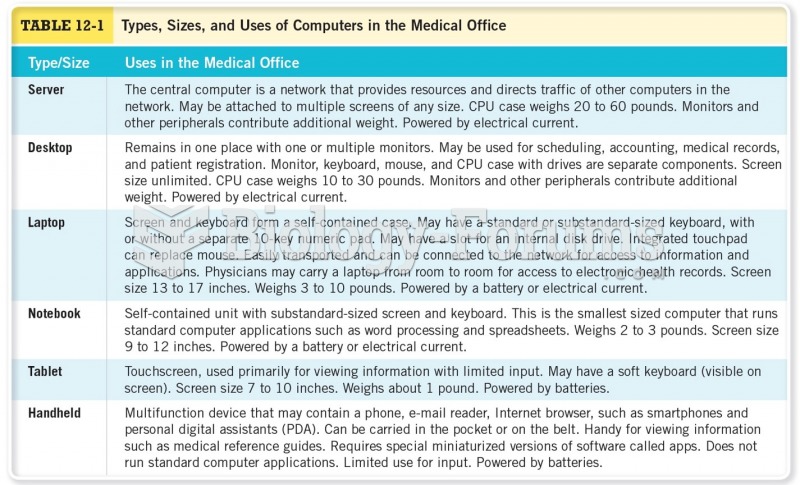Answer to Question 1
Computers play a part in psychiatry from diagnosis to treatment. CIDI (Composite International Diagnostic Interview) is an interview that screens for depression and anxiety. Computers have been used as a tool to screen teenagers for a variety of conditions, including suicidal tendencies. A program developed at the Columbia University College of Physicians and Surgeons prompts the interviewer to ask 3,000 questions and follow-ups. Anyone flagged by the computer is seen by a psychologist who then makes the diagnosis. Many psychological diagnostic tests, such as CIDI-Auto, are self-administered. One company advertises self-administered tests that they claim will help diagnose addiction, thought errors, and even criminal tendencies. They do warn, however, that these diagnoses are meant as suggestions only; they are not conclusive.
The first uses of computers in psychotherapy were in testing; later studies found the online tests comparable to traditional testing. Computers can be better at information gathering than clinicians. Some studies found that some people are more open with a computer-administered interview. More people were willing to participate in a computer-administered interview. A series of studies in 2004 found that computers and the Internet were helpful aids to therapy. Technological applications?include self-help Internet sites, computer-administered therapy, virtual reality therapy to name a few. The Web-based Depression and Anxiety Test (WB-DAT) was found effective in diagnosing anxiety disorders and depression. In computer-guided therapy, the computer itself both determines and provides the feedback to the patient. In a test in which the data concerning 193 subjects was taken from two studies of gamblers and one of major depressives, the WB-DAT did well in identifying people suffering from major depressive disorder, social phobias, obsessivecompulsive disorder (OCD), and posttraumatic stress disorder. Several programs that are effective include Fear Fighter for phobias and panic, BTSteps for OCD, and Overcoming Depression for depression.
Two programs have been found helpful for drinkingBehavioral Self-Control Program for Windows and Drinker's Checkup. Beating the Blues uses cognitivebehavioral therapy for depression and anxiety. Seven out of 10 people who used it would recommend it to friends. Although all patients using computer-aided therapies were in telephone contact with live therapists, computers apparently do a good job at some sorts of therapies. There is computer-aided self-help for phobia/panic, nonsuicidal depression, and OCD. Some patients with OCD and depression were given a self-help book with a telephone number to call a computer-operated interactive voice system. Self-help exposure programs on the Internet or on a PC aided people with panic disorder. Clients can carry palmtops that remind them of techniques to be used in everyday life; this is used as an aid in treating people with generalized anxiety disorder and social phobia. The Web can bring therapy to patients whose conditions may make them unlikely to seek treatment (including those with agoraphobia or OCD).
Later studies tended to confirm the 2004 studies. Online screening programs for anxiety and mood disorders have been generally equivalent to assessment by a therapist. Some self-help programs on computers have been shown to be effective; on the Internet, users can get feedback, making the programs more helpful. Internet-based treatment was found to be as effective as face-to-face treatment in a number of randomized clinical trials. The use of virtual reality (VR) in treating certain phobias has also been tested in randomized clinical trials and found to be effective. VR is being used to treat soldiers returning from Iraq with posttraumatic stress disorder. Internet therapy (Interapy) for those suffering from posttraumatic stress disorder was found to be very effective through self-reports. Interapy was also found to be effective in treating depression. The Internet-based treatment was cognitivebehavioral therapy in all cases studied. Because Interapy is relatively new, the evidence is limited concerning its effectiveness. Anxiety disorders have been treated for many years with controlled exposure to whatever provokes the anxiety. Investigations are being performed to see whether the exposure can be done using VR technology.
In 2010, advances in computer technology and artificial intelligence allowed the creation of complex virtual situations. These advances allow people to be exposed to situations that in real life they find threatening and frightening. They find the virtual situations threatening but know that they are safe. Researchers are using these virtual environments to see how people with certain conditions react to certain virtual situations, how heavy drinkers feel when a virtual bartender offers them a drink, how gamblers react to virtual slot machines, and how people with social anxiety give a speech to a virtual room full of virtual people. Because the therapist is in the situation at the moment, she or he can give immediate advice. Some experiments have shown that the advice does have an effect on actual behavior in the real world. Researchers are also attempting to use virtual people to improve the ability of autistic children to think and talk while surrounded by others. Use of virtual worlds in therapy is called cybertherapy, and it is a growing field. It is not meant to replace human therapy but to be used as a tool along with it.
In some situations, cybertherapists are being used. Angelina is a virtual human programmed to nod sympathetically and be socially sensitive. Talking with a student with a social anxiety disorder, Angelina's eyes and expression, guided by video cameras and microphones, stay in sync with the student's, as an empathetic therapist's would. While not looking quite human, Angelina is mobile and human enough to conduct a conversation that is somewhat natural. A recent study at the University of Southern California found that people tell her more of their fears than they tell live therapists. Angelina does not diagnose, but she asks if you want to see a therapist and can give you a list of therapists.
At the University of Quebec in Outaouais, people who suffer from social anxiety were put in two groups. One was given talk therapy for 1 hour per week for 14 weeks and the other talk therapy with cybertherapy. Both groups improved, and research is continuing to see if a combination of real and virtual therapy speeds recovery.
The U.S. Army is developing SimCoach, based on Angelina. SimCoach will conduct interviews with veterans and their families to see what problems they are experiencing. The vets will be able to use SimCoach anonymously and receive a list of therapists if needed.
Answer to Question 2
A







